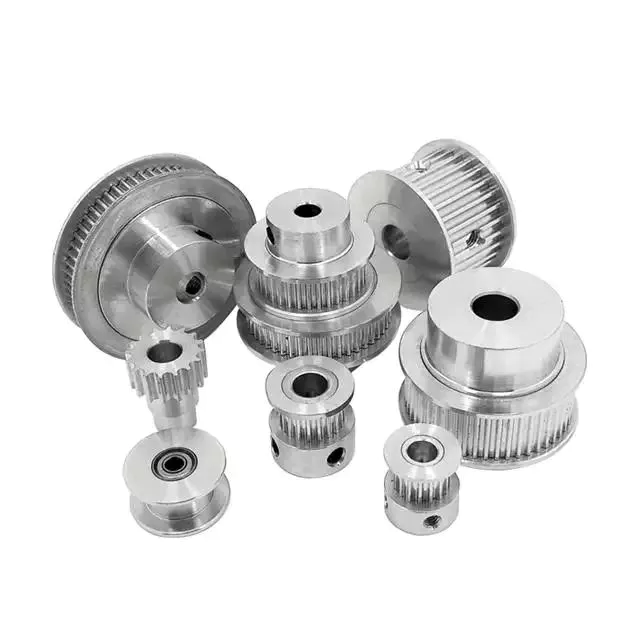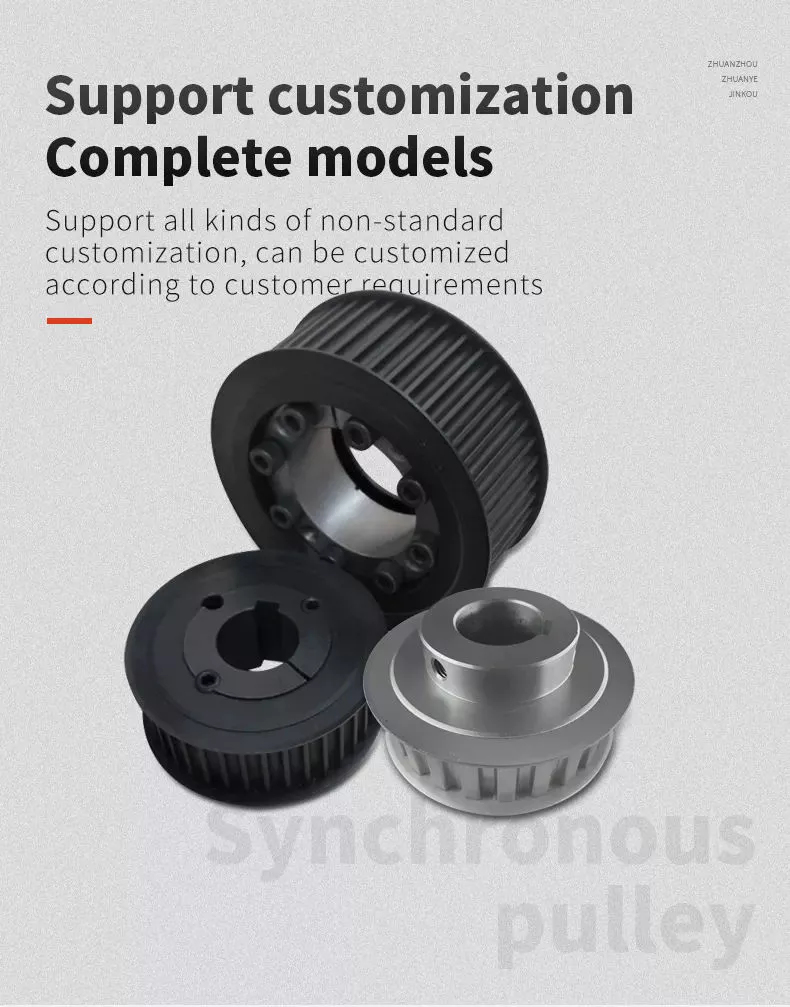وصف المنتج
وصف المنتج
Casting Iron Elevator Sheave Pulley for Lift Parts
Pulley Advantages:
1. Low cost &Low specific weight
2. Great rigidity ,hardness ,Corrosion resistant ,Friction-resistant and wear-resistant.
3. High impact value,Excellent sliding and emergency running properties
4. No, or very low moisture absorption
5. Dimensionally stable .Virtually no limit to the variety of dimensions and shapes
6. Low or no maintenance required
What’s more important is:
Energy efficient and environment-friendly and Can be customized ~
| Load | Speed | Outer diameter Φ | Inner diameter Φ | Wire rope diameter Φ | Grooves N |
| 450 | 0.5-1.75 | 320 | 80-110 | 8 | 3-4 |
| 550 | 1-1.75 | 320 | |||
| 630 | 1-1.75 | 320 | |||
| 800 | 1-1.75 | 320 | 100-120 | ||
| 400 | |||||
| 1000 | 1-2.5 | 320 | 110-130 | 8-10 | 5-8 |
| 400 | |||||
| 440 | |||||
| 480 | |||||
| 520 | |||||
| 1150 | 1-2.5 | 320 | 120-140 | 8-12 | 5-8 |
| 400 | |||||
| 440 | |||||
| 480 | |||||
| 520 | |||||
| 1250 | 1-2.5 | 400 | 120-140 | 8-12 | 6-8 |
| 440 | |||||
| 480 | |||||
| 500 | |||||
| 520 | |||||
| 1350 | 1-2.5 | 400 | 130-150 | 8-12 | 7-9 |
| 480 | |||||
| 520 | |||||
| 560 | |||||
| 1600 | 1-2.5 | 400 | 140-170 | 10-12 | 8-14 |
Company Infomation
Work Shop
CE Certifications
Project Cases
التعليمات
1. The Elevator Stable and Safe?
We with more than 10years production experience. Currently working with Ots,Kone and customers from more than 20countries.Our Products are Qualified with ISO9001,CE/EN81,EAC,KC.All the main parts which we use is international famous brand,make our elevator comes premium level.
2.How To Install and Maintain ?
We have been cooperated with elevator installation company more than 20countries,we never stop finding installation partner in other country everyday.To ensure our customer can enjoy both good quality and after-sales service.
3. Will The Elevator Drop Down or Clamp People Suddenly?
Our elevator get 6 lines protection ,In Machineroom,Elevator Door,Bottom of shaft. It will enter into the protection system automaticly if there is any issue .The elevator will not have such situation if the after service goes well.That’s why we have so many parters all over the world.
4. Any Cerifications ?
We are qualified with CE/EN81,EAC/CU-TR,KC,TUV Certificates.You are full protected.
Choose us.Choose ur Life Style!
| After-sales Service: | on-Line Tech. Guidance |
|---|---|
| ضمان: | 1year |
| يكتب: | Traction System |
| Suitable for: | Elevator, Funicular Car |
| Load Capacity: | 3000kg |
| Persons: | 11-20 |
| العينات: |
US$ 6.8/Piece
1 قطعة (الحد الأدنى للطلب) | |
|---|
| التخصيص: |
متاح
| طلب مخصص |
|---|

Can you explain the concept of “efficiency” in pulley systems?
In pulley systems, efficiency refers to the ratio of output work or power to the input work or power, taking into account any losses or inefficiencies in the system. It represents how effectively the pulley system converts the input energy into useful output energy.
The efficiency of a pulley system can be affected by various factors, including friction, mechanical losses, and the design and condition of the pulleys and ropes. Here are some key points to understand about efficiency in pulley systems:
1. Mechanical Advantage and Efficiency: Pulley systems can provide a mechanical advantage by reducing the effort force required to lift a load. However, it’s important to note that while a higher mechanical advantage generally means less effort is needed, it may also result in lower efficiency. This is because as the mechanical advantage increases, the system may experience higher frictional losses and other inefficiencies.
2. Friction and Efficiency: Friction plays a significant role in the efficiency of pulley systems. The interaction between the pulley wheels and the ropes or belts can result in frictional losses, which reduce the overall efficiency of the system. Friction can be minimized by using pulleys with low-friction bearings or by lubricating the contact surfaces.
3. Rope or Belt Material: The choice of rope or belt material can impact the efficiency of a pulley system. Different materials have varying coefficients of friction, flexibility, and durability, which can affect the overall efficiency. For example, using a rope or belt with low friction and high strength can help reduce energy losses and improve efficiency.
4. Pulley Design and Condition: The design and condition of the pulleys also influence efficiency. Pulleys should be properly aligned, have smooth surfaces, and be free from damage or wear. Misaligned or worn pulleys can increase friction and decrease efficiency.
5. System Load: The efficiency of a pulley system can vary based on the magnitude of the load being lifted or moved. Higher loads can result in increased friction and mechanical losses, leading to lower efficiency.
Efficiency is typically expressed as a percentage, with 100% representing a perfectly efficient system where all the input energy is converted into useful output energy. In real-world pulley systems, efficiency is often less than 100% due to various factors, including friction, heat generation, and other losses.
It’s important to consider efficiency when designing or evaluating pulley systems. Higher efficiency means a more effective use of input energy, reduced energy waste, and improved overall performance.

What role do pulleys play in modern elevators and hoists?
Pulleys play a crucial role in modern elevators and hoists, enabling the smooth and efficient vertical movement of loads. They are integral components of the lifting mechanisms, providing mechanical advantage and facilitating safe and controlled operation. Here’s how pulleys are used in modern elevators and hoists:
1. Lifting Mechanism: In elevators and hoists, pulleys are part of the lifting mechanism that moves the load vertically. They are typically combined with cables, ropes, or belts to create a pulley system. By distributing the load’s weight across multiple lines and changing the direction of the applied force, pulleys make it easier to lift heavy loads. The number and arrangement of pulleys can vary depending on the specific design and requirements of the elevator or hoist.
2. Counterweight Systems: Modern elevators often utilize counterweight systems to offset the weight of the elevator car and reduce the amount of power required for operation. Pulleys play a crucial role in these systems by guiding the cables connected to the counterweight. As the elevator car moves up or down, the counterweight moves in the opposite direction, balancing the load. The pulleys in the counterweight system help distribute the weight and ensure smooth movement.
3. Traction Control: Pulleys are also involved in the traction control mechanism of elevators and hoists. Traction elevators use ropes or belts that pass over a series of pulleys, known as sheaves, to create traction. An electric motor drives the sheaves, causing the ropes or belts to move. By adjusting the rotational movement of the sheaves, the speed and direction of the elevator or hoist can be controlled. The pulleys in the traction control system enable precise and reliable operation.
4. Safety Systems: Pulleys play a crucial role in the safety systems of elevators and hoists. For example, in traction elevator systems, overspeed governors utilize pulleys to detect excessive speed and activate the safety brakes in case of a malfunction. The pulleys in these safety systems help monitor and control the elevator’s speed, ensuring passenger safety.
5. Maintenance and Service: Pulleys in modern elevators and hoists are designed to be durable and require minimal maintenance. They are often equipped with sealed bearings or other lubrication systems to reduce friction and wear. This ensures the longevity and reliability of the pulley systems, minimizing downtime and maintenance costs.
Overall, pulleys are essential components in modern elevators and hoists, enabling vertical movement, providing mechanical advantage, ensuring safety, and facilitating efficient operation. They contribute to the smooth and controlled lifting of loads, making elevators and hoists reliable and indispensable tools in various industries and buildings.

في أي الصناعات يتم استخدام البكرات على نطاق واسع؟
تُستخدم البكرات على نطاق واسع في العديد من الصناعات لمجموعة واسعة من التطبيقات. وفيما يلي بعض الصناعات التي تُستخدم فيها البكرات على نطاق واسع:
1. التصنيع والصناعة: تُستخدم البكرات على نطاق واسع في التصنيع والبيئة الصناعية. وتُستخدم في أنظمة النقل لمناولة المواد وخطوط التجميع وعمليات الإنتاج. وتُستخدم البكرات أيضًا في الآلات والمعدات مثل المضخات والضواغط والمولدات والناقلات. وتعتمد هذه الصناعات على أنظمة البكرات للحركة الفعالة للمواد ونقل الطاقة والميزة الميكانيكية.
2. البناء والهندسة: تعتمد صناعات البناء والهندسة بشكل كبير على البكرات لرفع وتحريك الأحمال الثقيلة. تستخدم الرافعات والرافعات الشوكية ورافعات الأوناش أنظمة البكرات لتوفير ميزة ميكانيكية وتحكم دقيق في عمليات الرفع. تُستخدم البكرات أيضًا في أنظمة السقالات والمصاعد ومعدات مناولة المواد المستخدمة في مشاريع البناء.
3. التعدين واستغلال المحاجر: في عمليات التعدين واستغلال المحاجر، تُستخدم البكرات في تطبيقات مختلفة. وتُستخدم في أنظمة النقل لنقل المواد السائبة مثل الفحم والخام والركام. تلعب البكرات دورًا حاسمًا في معدات التعدين مثل الكسارات والشاشات والحفارات، مما يتيح مناولة المواد ومعالجتها بكفاءة.
4. النقل والخدمات اللوجستية: تستخدم صناعات النقل والخدمات اللوجستية البكرات بطرق مختلفة. تعد البكرات مكونات أساسية في المركبات، بما في ذلك السيارات والشاحنات والحافلات والقطارات. تُستخدم في المحركات وأنظمة التوجيه المعزز والمولدات وأنظمة تكييف الهواء. في الخدمات اللوجستية، تُستخدم البكرات في أحزمة النقل وأنظمة الفرز من أجل نقل الطرود والبضائع بكفاءة في المستودعات ومراكز التوزيع.
5. الزراعة: للبكرات تطبيقات مهمة في قطاعي الزراعة والزراعة. فهي تستخدم في الآلات مثل الجرارات والحصادات والحصادات لنقل الطاقة وأنظمة الدفع. كما تستخدم البكرات في أنظمة الري وصوامع الحبوب ومعدات معالجة الأعلاف.
6. البحرية والبحرية: تستخدم البكرات على نطاق واسع في الصناعات البحرية والبحرية. فهي تستخدم في بناء السفن، ومنصات الحفر البحرية، والمعدات البحرية. كما تستخدم البكرات في الرافعات، والرافعات، وأنظمة المرساة، وتطبيقات التجهيز. وهي تمكن من رفع وخفض وتحديد مواقع المعدات الثقيلة والبضائع على السفن والمنصات البحرية بأمان وكفاءة.
7. الطاقة والمرافق: يستخدم قطاع الطاقة والمرافق البكرات في أنظمة توليد ونقل الطاقة. تُستخدم البكرات في التوربينات والمولدات ومحطات الطاقة لنقل الحركة الدورانية ونقل الطاقة. كما تُستخدم أيضًا في أنظمة الطاقة المتجددة مثل توربينات الرياح ومحطات الطاقة الكهرومائية.
8. الترفيه والإنتاج المسرحي: تستخدم البكرات في صناعات الترفيه والإنتاج المسرحي. فهي تستخدم في أنظمة تجهيز المسارح، ومسارح الحفلات الموسيقية، وألعاب الملاهي. تتيح البكرات التحكم في حركة الديكور ومعدات الإضاءة والفنانين، مما يضمن عمليات سلسة ودقيقة.
هذه مجرد أمثلة قليلة للصناعات التي تستخدم فيها البكرات على نطاق واسع. تلعب البكرات دورًا حاسمًا في مجموعة واسعة من التطبيقات، حيث توفر ميزة ميكانيكية ونقل الطاقة والحركة الفعالة للأحمال في العديد من القطاعات الصناعية.


محرر بواسطة CX
2023-12-08
